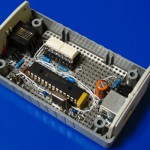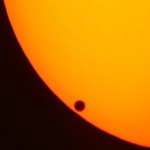The rearrangement of my astrophoto setup proceeds. If somewhat frantically in the face of the upcoming Transit of Venus. Another device has joined the toolkit, a bit of hand-wired electronica that gets the job done.

I did not design the device this time. This would have been completely within my capability, but why do so when someone else has already done the job? This is typical within the astronomy hobby, where many designs are shared for the benefit of everyone. In this case it is the USB to ST4 adapter designed by Gene Nolan.
All I had to do was follow the schematic and download the code into the microcontroller, the device worked first time. Gene does sell kits, but I wanted to do this quickly and had everything I needed on hand except the microcontroller and opto-isolators.
The only real problem that cropped up during construction was the wrong part received for the opto-isolators. The DigiKey description read DIP-8, so I ordered it, expecting to get something that fit into the DIP socket I had already wired onto the board. When the parts arrived I found that they were indeed DIP… lead-formed DIP packages meant to be surface mounted, with chopped off leads. I ended up soldering the devices to another DIP socket, using it as a header, which then plugged into the socket on the board. It looks funny, but it works.
It did take a couple hours of downloading and installing the drivers and other useful software packages to get everything working. This includes the very useful ASCOM driver framework, and PHD Guide. Both of which I plan to use beyond the upcoming Transit of Venus to do more astrophotography.
My wife may have been a little perturbed by the testing setup strung across the kitchen table, a laptop and the heavy Losmandy head, a Canon 60D camera, all connected by a snake pit of cables. But it worked, first time, that is always nice.

